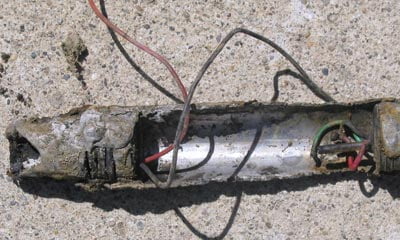 In conditions that fall outside the manufacturer’s recommendations, it’s important to manage the environment around your pressure sensor. Otherwise, your sensor’s performance can easily suffer. In worst-case scenarios, sensor failure can result in dangerous conditions.
In conditions that fall outside the manufacturer’s recommendations, it’s important to manage the environment around your pressure sensor. Otherwise, your sensor’s performance can easily suffer. In worst-case scenarios, sensor failure can result in dangerous conditions.
Chemical incompatibilities should be avoided entirely. Be sure to select a sensor with wetted materials that are completely compatible with the application media and any other chemicals that may contact any part of the sensor.
The wetted material is defined as the sensor material that comes into contact with the application media under normal operating circumstances. For example, the sensor diaphragm and the process fitting would be considered the wetted material.
It’s important to consider what normal operating circumstances are. For example, if it’s conceivable that other parts of the sensor may contact chemicals, you might want to check compatibility for the entire sensor housing and any chemical of concern. A good reference for this can be found here.
Submersible pressure sensors are a good example because the transducer, the housing, and the cable are all contacting the application media. Therefore, the entire sensor and its cable are considered wetted materials.
Our PT-503 submersible pressure transducers are a good fit for chemical applications.
In hot or cold environments, temperature control can be difficult. To help you know when you need to control the temperature, pressure transmitters come with a few guidelines in the form of (up to) three temperatures ranges:
Keep in mind, that both the media and external temperatures are important. When selecting a sensor, use the more extreme temperature range for your specification. For extremely cold temperatures, you may need a heated enclosure to keep the sensor warm. For high media temperatures, you may be able to use a standoff pipe to remove the sensor from the heat source.
NEMA and IP ratings exist for a reason – moisture can ruin your sensor. Be sure that your sensor’s housing is rated appropriately for the application. If it is not, it must be stored in an enclosure that is properly rated.
Dust is also a concern in high enough concentrations. NEMA and IP ratings also cover dust protection. For IP ratings, the first number deals with how well the enclosure or sensor housing protects against dust ingress, while the second number is for liquid. NEMA ratings are not as straight forward, and include other problems such as ice, oils, coolants, etc. We wrote about NEMA and IP ratings a little while ago, and created a conversion chart if you would like to learn more.
Be mindful of airtight enclosure in extreme temperature swings. Condensation will occur inside the enclosure as temperatures change. Vent the enclosure with a waterproof barrier such as Gore-Tex®, and use a desiccant cartridge to absorb any moisture in the air.
Properly maintaining the application environment will ensure your pressure transducer works as it should, and lasts a while too. Make sure you contact us if you have any questions about pressure sensors, their corresponding environmental specifications, or controlling the environment in the field.